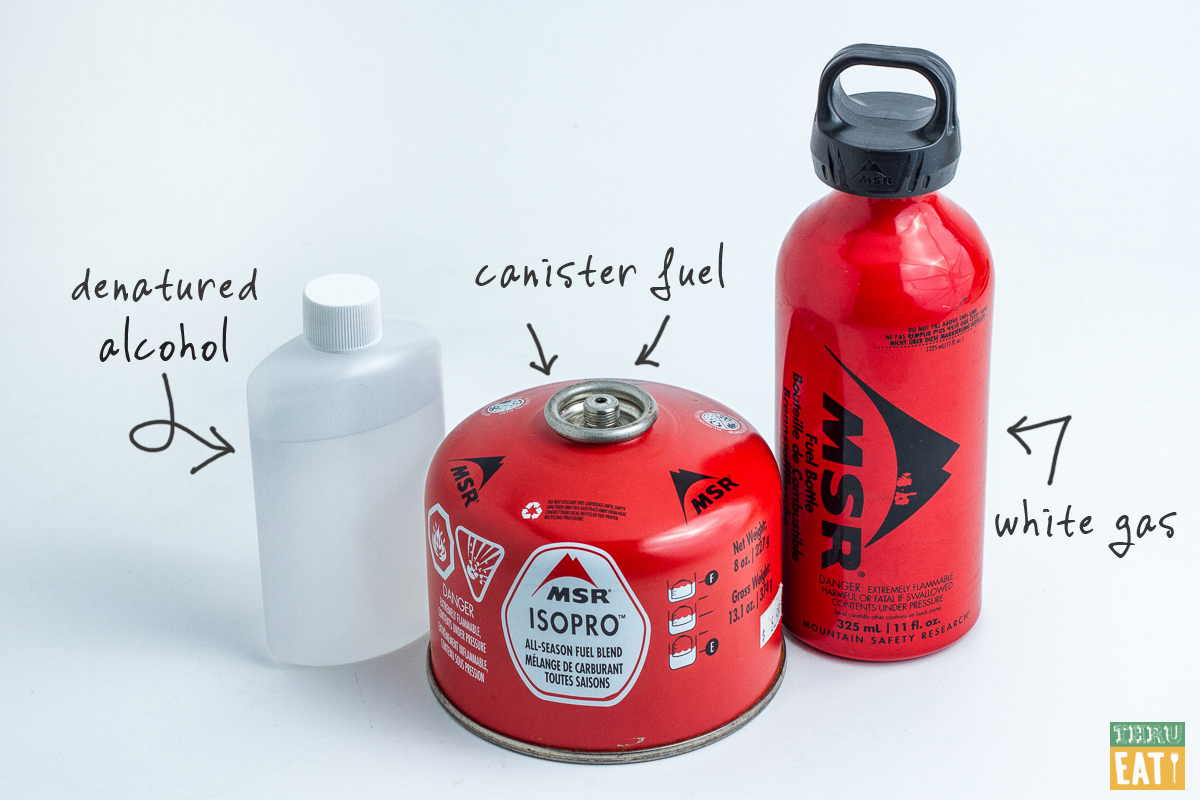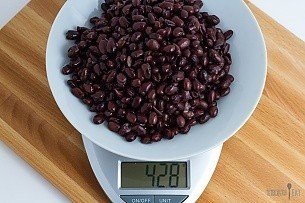There are certain factors and preferences that might lead you to use one fuel over another. In order to determine what fuel to use you need to evaluate your backpacking itinerary, your meal plan (is it just add water or do you need to simmer?), and decide what’s important to you and what you’re willing to sacrifice in exchange for it.

At the end of the day just about anything that burns can be used to cook delicious backpacking meals, but some options may be lighter, more convenient, or more affordable. If you already have significant backpacking experience then you likely already have a preference, but if this is all new to you, don’t worry, you’ll probably end up trying all types of fuels through your backpacking career anyway. Here are the gritty details on the more popular options:
Isobutane/propane blend (canister gas). These are dome shaped gas canisters you’ve probably seen at the local sporting good stores and on the trail. It’s a blended gas made by a number of manufacturers with different specifications, some brands you might recognize are: MSR ISOPRO, JetBoil Jet Power, Primus Power Gas, Coleman, and Snow Peak Giga Power. They usually come in two or three sizes but all have a Lindal B188 threaded nipple so you can use whatever brand you desire. The only caveat is a canister made by Camping Gaz, which looks very similar but doesn’t use a threaded connector—avoid it.
Pros:
Easy to find at most trailheads, resupply locations, and sporting good stores.
Burns very clean, leaving no residue on the stove or cookware.
Relatively affordable at $5-8 per 8oz. cannister.
Very convenient for backpacking, just light the stove and use.
Cons:
Not easily recyclable. Spent canisters must be safely vented, punctured, and not all recycling programs will accept it.
Poor cold weather performance, and even worse when the canister starts to run low. However, some stoves (like the MSR WindPro II) are designed to use the canister upside down which solves the cold weather issue.
If you need extra fuel you’ll have to carry two bulky canisters as they can’t be refilled.
Not straightforward figuring out how much fuel is left in the can.
White gas. A classic liquid camp fuel used heavily before the advent of modern gas fuel blends and storage vessels. It’s typically a naphtha based fuel without any additives; it’s not gasoline, do not use gasoline.
Pros:
Incredibly cheap. $15 for 1 gallon that will run a stove for many hours.
Stored in a fuel bottle so it can be refilled, topped off, shared, or used to start fires.
More environmentally friendly. No wasteful canisters to throw away and you can look into the bottle to see remaining fuel levels.
Very good cold weather performance.
Cons:
Requires a heavy bulky bottle to function.
Stove needs to be primed and pumped in order to work.
Can burn dirty, leaving soot on stove and cookware; and potentially clog the stove.
Fuel isn’t difficult to find, but not as readily available or prominently displayed as canister fuels.
Denatured alcohol. Basically booze that you can’t drink. It’s chemically the same stuff (ethanol) that gets you drunk, but it contains additives to make it undrinkable for tax and regulatory purposes.
Pros:
Also very cheap to purchase and can be found at the hardware store or marine supply store.
Burns very clean.
Great fuel stability, so it can be stored and transported in lightweight plastic bottles.
Stoves are typically in the ultralight category and easily homemade out of soda cans.
Cons:
No fine control of heat output. It’s either full blast output or low. Yes, simmer rings exists but it’s still a manual process.
Flames can be hard to see unless it’s dark out. This can be addressed by feel or by adding salt to the fuel.
Can be difficult to use and unsafe if it’s very windy.
It can get dangerous if you’re not careful about pouring your fuel.
Wood. Mankind’s first known fuel, and still used the world over. This is popular amongst the ultra ultralight crowd because obviously you don’t have to carry fuel, just pick it off the ground. It is a viable fuel source that I mention very reluctantly because I think it only excels in a very small range of situations, and would otherwise be too much hassle. If you camp in heavily wooded areas that aren’t prone to forest fires then it’s worth looking at, otherwise, pass over this.
Pros:
Insanely lightweight, you just need to carry the stove which is usually very light and collapses down completely flat.
Cons:
Cannot be used above treeline, anywhere without small twigs and branches, or in places with fire restrictions.
Can be very difficult to light and get going, especially if things are a little damp.
Burns dirty and will leave your cookware covered in soot.
It puts out smoke so you won’t be able to camp discretely.
Requires extra care and precaution not to accidentally start a forest fire.
White gas and denatured alcohol are typically more “advanced” fuels, and by that I mean they require marginally more effort and care. Let me be clear, I don’t mean a beginner shouldn’t use these fuels, but rather, they’re enough of a hurdle that the benefits may not be immediately worthwhile to someone who is brand new to backpacking.
Denatured alcohol has the lowest energy density of all three fuel types (we’re ignoring wood) and may appear to be a bad choice, but it’s secretly a winner. The lower energy density means it’s not extremely volatile and can be kept in plastic bottles, bringing only the fuel you need, instead of heavy and bulky canisters. In addition, the stove isn’t subjected to intense temperatures and thus, can be incredibly lightweight. It does however require a brief priming period for the alcohol to vaporize before it’ll burn properly, which depends on ambient temperature and stove design.
In terms of trail cooking, the lightweight nature of alcohol stoves means it can be a little unstable without additional pot supports. Because there’s typically a lot of stirring involved when reconstituting our backpacking meals it means extra care must be taken to avoid tipping over the stove.
On the opposite side of the weight spectrum is white gas. It requires storage in a metal container and uses pressure to deliver fuel to the stove. And like alcohol, requires a period of priming in order to get the liquid fuel to vaporize and burn. The necessary components to make it all function are much heavier in comparison and typically not the most user friendly to use. It does however have a place to shine, and that’s in high elevation cold weather. It will burn happily in the most hostile of environments where other fuels might struggle.
If you want to jump right in and explore these fuels that’s okay and you’ll probably be fine. Just be sure to try it out at home and in different scenarios before you hit the trail for an extended trip. Above all else, remember that these liquid fuels need to be handled with care, and should be used away from anything that can catch fire.
The Bottom Line on Backpacking Fuel*
(*for beginners and most backpackers)
Use canister gas. Canister gas will likely cover the needs of most backpacking trips and is probably the most commonly used. While it’s more expensive compared to white gas and alcohol, it’s not much more so. It’s readily available and more importantly, easy to use. If you’re just starting out backpacking or wilderness camping this should be your first fuel type. It doesn’t require any priming, pouring, or guesswork; it’s controlled with a twist of a valve much like a home stove. Easy. It will allow you to simmer your dehydrated backpacking meals without burning, but that may depend on your stove design.
If you’re a more experienced backpacker you might be looking to expand your repertoire or address some shortcomings of canister gas (weight and bulk!) An alcohol stove would be the next logical step, but be sure to bring along a simmer ring, a sturdy pot stand, and snuffer for your stove. Don’t forget to bring your patience either, sometimes it can take a little longer to get the stove started and the boiling times may be slightly longer if the weather isn’t particularly friendly.
Serious mountaineers probably don’t need any advice about white gas stoves. But I’ll mentioned that white gas isn’t necessarily the de facto standard anymore for cold weather trips as most canister gases nowadays are four season blends designed to work in all conditions. If you keep the canister near your body to keep it warm it’ll work just fine.
There are also remote canister stoves with preheat loops (called generators) that allow the canister to function upside down. This causes the fuel to leave the canister in liquid form (since it doesn’t vaporize as well when cold) and then vaporize within the generator. If you’re carrying crampons and ice axes the last thing you want is the extra weight of white gas. For what it’s worth, I think it’s pretty telling that spent canister gas is littered all over the place in camps above Everest Base Camp.




